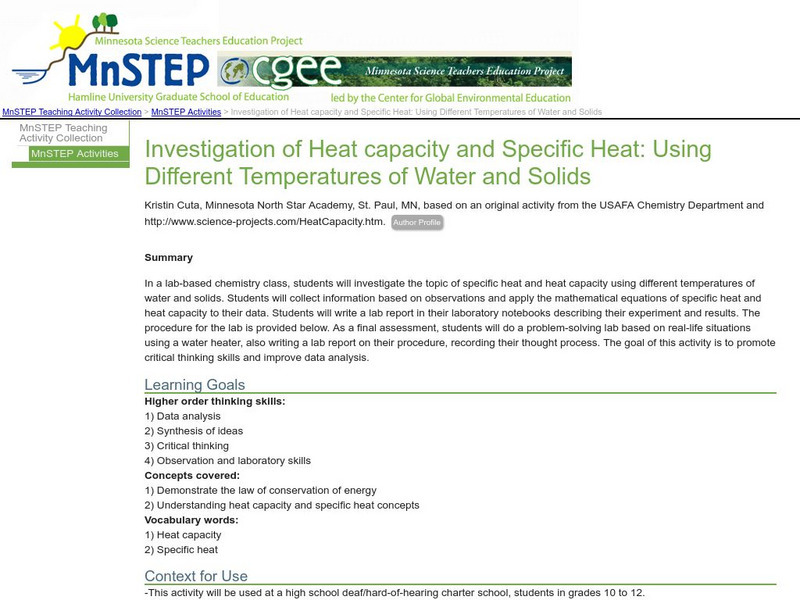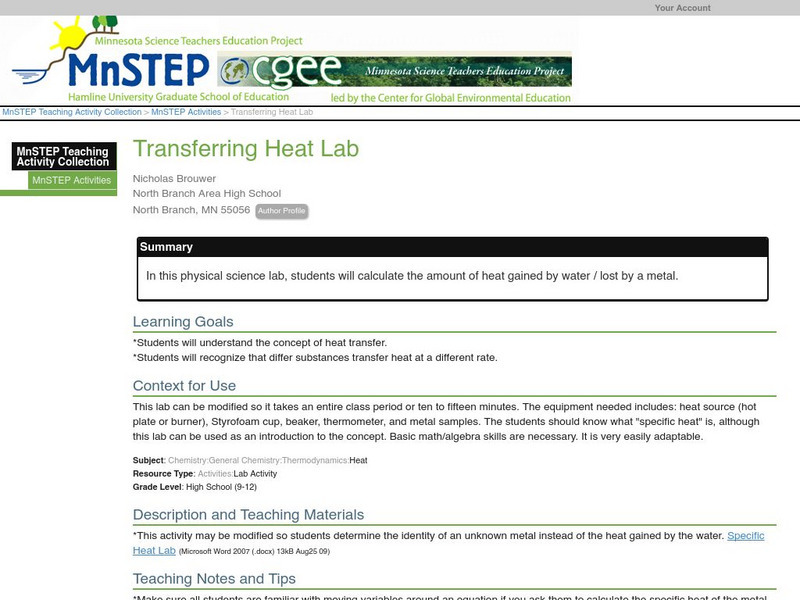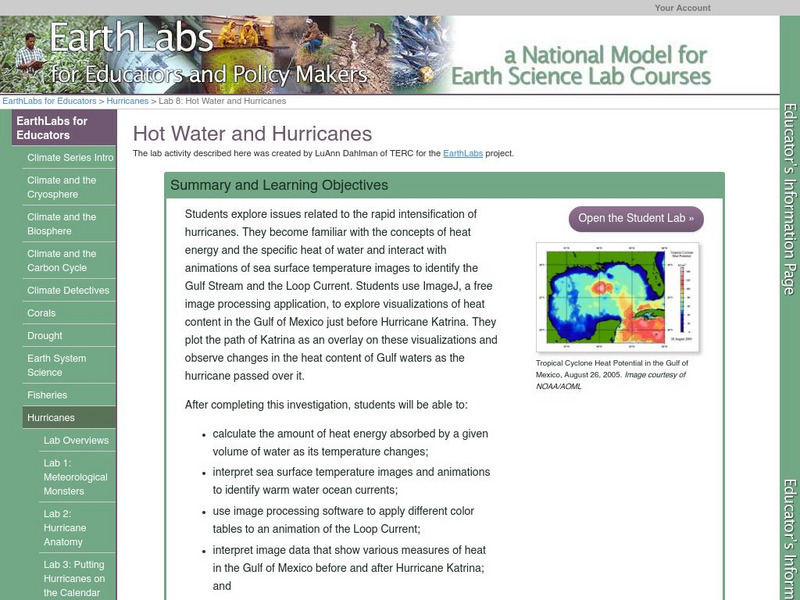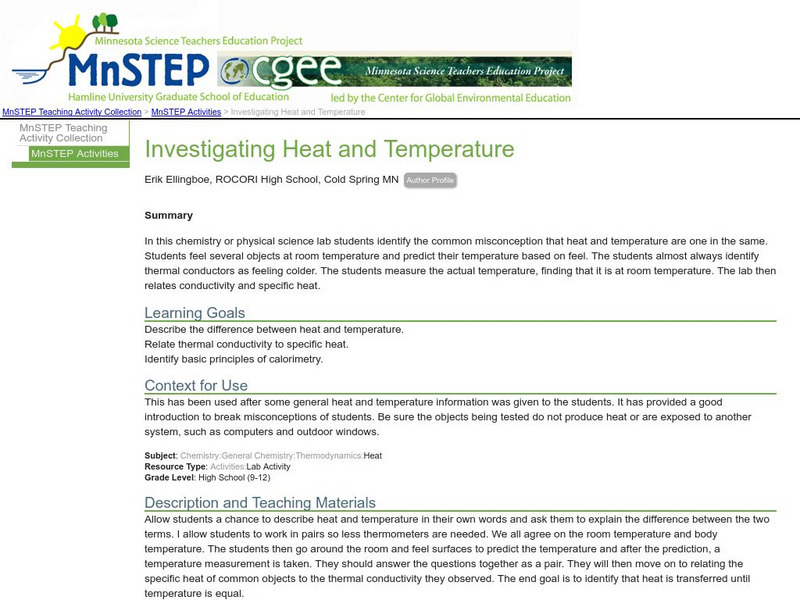Cornell University
Nano What?
The size of a nanoparticle is difficult for pupils to grasp. A hands-on experiment is designed to give your classes perspective. Learners analyze different sports drinks for the content of electrolytes as an introduction to nanoscale....
Curated OER
# 18 Determination of the Set Time for Epoxy Adhesive
Students recognize epoxy glue formation as two part polymerization (usually the curing agents act as co-monomers). They monitor the reaction by the changes in viscosity of the reacting mass, the temperature rise and fall, and the...
Virginia Polytechnic Institute and State University
Lesson Plan: Successful Microwave Cooking
No need to be involved in a home economics or cooking courses to take advantage of this resource. Not only is there an explanation for how microwaves work but there are also tips for how to use the microwave, and cautions...
Curated OER
Flame Test
Students conduct a flame test on different substances. In this chemistry lesson, students predict the element present based on the color emitted during the flame test. They explain how different elements produce different colors.
Curated OER
Teaching About the Properties of Water
Students use video, Internet research, graphs and tables, worksheets and hands-on experiments to investigate the properties of water in a lake environment. They work under direction or through an inquiry process.
Curated OER
Will It Grow?
Fifth graders conduct experiments involving plants. In this science lesson plan, 5th graders design an experiment involving plants. Students use the scientific method to design their experiments.
Curated OER
Not a Drop to Drink
Pupils design an experiment to determine which liquid is water. In this chemistry instructional activity, students perform the experiment as outlined in their design. They record observation and formulate conclusion.
Curated OER
Succession in the Classroom
Students investigate their environment by growing plants in class. In this botany activity, students discuss the lifespan of plants and animals and how they must be cared for continuously over time. Students grow a plant in...
Curated OER
Water and Ice
Students investigate how water changes state. In this water lesson, students observe, measure, and describe water as it changes state. This lesson includes extensions which can be accessed via the provided web links.
Curated OER
Hot air Balloons
Students study how hot air balloons were created and the different types there are. For this density and lift lesson students build their own hot air balloon.
Curated OER
Igniting Chemistry in Fireworks
Students watch a video segment and read text about the color of fireworks. Students watch a video segment and do an interactive activity on the mechanics of a firework.
Curated OER
Igniting Chemistry in Fireworks
High schoolers watch a video segment and read text about the color of fireworks. Students watch a video segment and do an interactive activity on the mechanics of a firework.
Curated OER
Igniting Chemistry in Fireworks
Students watch a video segment and read text about the color of fireworks. Students watch a video segment and do an interactive activity on the mechanics of a firework.
Curated OER
Aerospace Engineering
Students explore oil field applications of Shape Memory Alloys. In this engineering lesson students divide into groups and research mini research applications then complete a project.
Curated OER
UV Radiation and the Developmental Stages of Red Flour Beetles
Students perform an experiment to compare the sensitivity of the various developmental stages of Red Flour Beetles to ultraviolet radiation. Larvae, pupae and adult beetles are exposed to a source of UV-B radiation. In groups, they...
Curated OER
Not Just For A Baby's Bottom
Eighth graders investigate the presence of talc in the geologic record. The different characteristics of talc is covered. The instructional activity includes background information for the teacher.
Physics Aviary
Physics Aviary: Guided Specific Heat Lab
This lab is designed to have students learn how to calculate the specific heat of a liquid based on the temperature changes that occur when hot water is added to the liquid.
Science Education Resource Center at Carleton College
Serc: Investigation of Heat Capacity and Specific Heat
A lab experiment where students use different temperatures of water and solids to study specific heat and heat capacity. By applying mathematical equations, students can use their data to calculate specific heat and heat capacity. Lesson...
Physics Aviary
Physics Aviary: Guided Specific Heat of Solid Lab
This lab is designed to have students learn how to calculate the specific heat of a solid based on the temperature changes that occur when a hot solid is added to cold water.
Science Education Resource Center at Carleton College
Serc: Transferring Heat Lab
In this physical science lab, learners calculate the amount of heat transfer between water and a metal.
Science Education Resource Center at Carleton College
Serc: Lab 8: Hot Water and Hurricanes
A lab experiment in a series of experiments that explores hurricanes. In this lab experiment, students will investigate the concepts of heat energy and specific heat of water to explore issues related to the rapid intensification of...
Other
Physics Labs/specific Heat (C) of Metal
A complete set of directions, notes, and suggestions for a lab involving the determination of the specific heat values for various metals. Suitable for a student project or lab investigation.
Science Education Resource Center at Carleton College
Serc: Investigating Heat and Temperature
In this lab, students will be able to describe the difference between heat and temperature. Students will feel several objects at room temperature and predict their temperature based on feel. They will then measure the actual temperature...
Chemistry Collective
Chem Collective: Measuring the Heat Capacity of an Engine Coolant.
As an analytical chemist at a company developing new engine coolants your task is to determine the heat capacity of a newly developed product and then to determine if its heat capacity is greater of less than that of ethylene glycol.




















